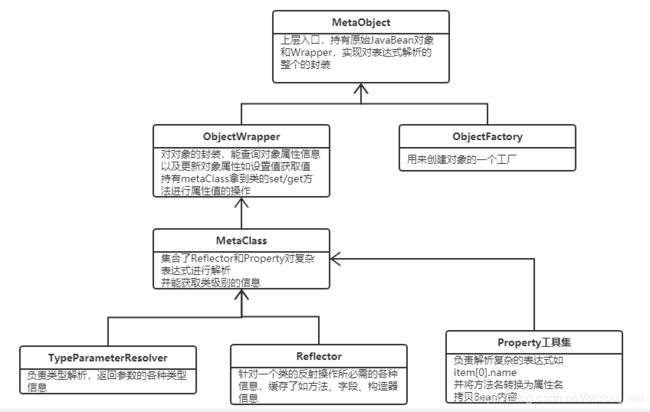Mybatis源码解析——反射工具箱
反射工具箱
Reflector
一个Class类对应的Reflector对象包括:
//对应的Class类型
private final Class<?> type;
//可读属性(有get方法的)名字数组
private final String[] readablePropertyNames;
//可写属性(有set方法的)名字数组
private final String[] writeablePropertyNames;
//set方法,key为属性名称,value是Invoker对象(对set方法对应的method对象的封装)
private final Map<String, Invoker> setMethods = new HashMap<String, Invoker>();
//get方法
private final Map<String, Invoker> getMethods = new HashMap<String, Invoker>();
//set方法的参数类型
private final Map<String, Class<?>> setTypes = new HashMap<String, Class<?>>();
//get方法的返回值类型
private final Map<String, Class<?>> getTypes = new HashMap<String, Class<?>>();
//默认构造器
private Constructor<?> defaultConstructor;
//所有属性名称,全大写形式
private Map<String, String> caseInsensitivePropertyMap = new HashMap<String, String>();
以上属性会在构造方法中进行填充
public Reflector(Class<?> clazz) {
type = clazz;
addDefaultConstructor(clazz);
addGetMethods(clazz);
addSetMethods(clazz);
addFields(clazz);//没有set/get方法时会使用Field操作
readablePropertyNames = getMethods.keySet().toArray(new String[getMethods.keySet().size()]);
writeablePropertyNames = setMethods.keySet().toArray(new String[setMethods.keySet().size()]);
for (String propName : readablePropertyNames) {
caseInsensitivePropertyMap.put(propName.toUpperCase(Locale.ENGLISH), propName);
}
for (String propName : writeablePropertyNames) {
caseInsensitivePropertyMap.put(propName.toUpperCase(Locale.ENGLISH), propName);
}
}
addGetMethods
private void addGetMethods(Class<?> cls) {
Map<String, List<Method>> conflictingGetters = new HashMap<String, List<Method>>();
Method[] methods = getClassMethods(cls);
for (Method method : methods) {
if (method.getParameterTypes().length > 0) {
continue;
}
String name = method.getName();
if ((name.startsWith("get") && name.length() > 3)
|| (name.startsWith("is") && name.length() > 2)) {
name = PropertyNamer.methodToProperty(name);
addMethodConflict(conflictingGetters, name, method);
}
}
resolveGetterConflicts(conflictingGetters);
}
ReflectorFactory
主要提供Reflector对象的创建和缓存,使用concurrentMap缓存对象,key为类
TypeParamterResolver
Type接口的实现类:
- Class
- ParameterizedType:参数化类型,如
List- Type getRawType():返回参数化类型中的原始类型;如
List返回List - Type[] getActualTypeArguments():返回类型变量或实际类型列表,如
List返回String - Type getOwnerType():返回类型所属关系;如
A类的内部类Inner的类型为A
- Type getRawType():返回参数化类型中的原始类型;如
- GenericArrayType:数组类型且组成元素是ParameterizedType或TypeVariable;如
List[] - Type getGenericComponentType():返回数组组成的元素
- TypeVariable:类型变量,反应JVM编译该泛型前的信息
- Type[] getBounds():获取类型变量的上边界,未声明则为Object;如
Test中K的上界为Persion - D getGenericDeclaration():获取声明该类型变量的原始类型;如
Test原始类型为Test - String getName():获取在源码中定义时的名字,
Test中为K
- Type[] getBounds():获取类型变量的上边界,未声明则为Object;如
- WildcardType:表示通配符泛型如
? super Integer- Type[] getUpperBounds():返回范型变量上届
- Type[] getLowerBounds():返回范型变量下届
ObjectFactory
用来创建对象的工厂,默认实现DefaultObjectFactory其create()调用instantiateClass(),最终调用Constructor.newInstance()
Property工具集
PropertyTokenizer负责解析表达式,可以迭代处理PropertyNamer负责将方法名转换为属性名(去掉is\set\get等前缀并首字母小写)以及检测是否是set、get方法或属性PropertyCopier同类型的Bean的属性值拷贝,核心方法为copyBeanProperties()
MetaClass
使用Reflector和PropertyTokenizer组合实现对复杂属性表达式的解析
MetaClass的构造函数接收一个类并为这个类构建Reflector对象
MetaClass.findProperty()会调用buildProperty(),最终通过PropertyTokenizer解析复杂属性表达式
PropertyTokenizer的解析方式见上文,MetaClass.hasGetter()和MetaClass.hasSetter()最终都是通过Reflector来实现的
ObjectWrapper
MetaClass是对类级别元信息的封装和处理,ObjectWrapper是对对象的包装,定义了一系列查询对象属性,更新属性的方法
public interface ObjectWrapper {
Object get(PropertyTokenizer prop);
void set(PropertyTokenizer prop, Object value);
String findProperty(String name, boolean useCamelCaseMapping);
String[] getGetterNames();
String[] getSetterNames();
Class<?> getSetterType(String name);
Class<?> getGetterType(String name);
boolean hasSetter(String name);
boolean hasGetter(String name);
MetaObject instantiatePropertyValue(String name, PropertyTokenizer prop, ObjectFactory objectFactory);
boolean isCollection();
void add(Object element);
<E> void addAll(List<E> element);
}
BaseWrapper是抽象类,封装了MetaObject对象,并提供了三种方法
- getCollectionValue
- setCollectionValue
- resolverCollection:会调用MetaObject.getValue()
getCollectionValue会根据PropertyTokenizer中的index取值
protected Object getCollectionValue(PropertyTokenizer prop, Object collection) {
if (collection instanceof Map) {
return ((Map) collection).get(prop.getIndex());
} else {
int i = Integer.parseInt(prop.getIndex());
if (collection instanceof List) {
return ((List) collection).get(i);
} else if (collection instanceof Object[]) {
return ((Object[]) collection)[i];
} else if (collection instanceof char[]) {
return ((char[]) collection)[i];
} else if (collection instanceof boolean[]) {
return ((boolean[]) collection)[i];
} else if (collection instanceof byte[]) {
return ((byte[]) collection)[i];
} else if (collection instanceof double[]) {
return ((double[]) collection)[i];
} else if (collection instanceof float[]) {
return ((float[]) collection)[i];
} else if (collection instanceof int[]) {
return ((int[]) collection)[i];
} else if (collection instanceof long[]) {
return ((long[]) collection)[i];
} else if (collection instanceof short[]) {
return ((short[]) collection)[i];
} else {
throw new ReflectionException("The '" + prop.getName() + "' property of " + collection + " is not a List or Array.");
}
}
}
BeanWrapper针对的是javaBean
public Object get(PropertyTokenizer prop) {
//存在索引信息
if (prop.getIndex() != null) {
//拿到集合对象
Object collection = resolveCollection(prop, object);
//获取对应索引处的值
return getCollectionValue(prop, collection);
} else {
//通过metaClass操作反射get方法
return getBeanProperty(prop, object);
}
}
MetaObject
完成对属性表达式解析的过程,最上层
//原始JavaBean对象
private final Object originalObject;
//JavaBean的ObjectWrapper对象
private final ObjectWrapper objectWrapper;
//实例化originalObject的工厂
private final ObjectFactory objectFactory;
private final ObjectWrapperFactory objectWrapperFactory;
private final ReflectorFactory reflectorFactory;
MetaObject的构造方法会根据传入的原始对象类型以及ObjectFactory 的实现创建相应ObjectWrapper 对象
MetaObject和ObjectWrapper中的对类级别的方法如:hasGetter()都是通过MetaClass操作的
对对象级别方法如:getValue是通过与ObjectWrapper配合实现的



